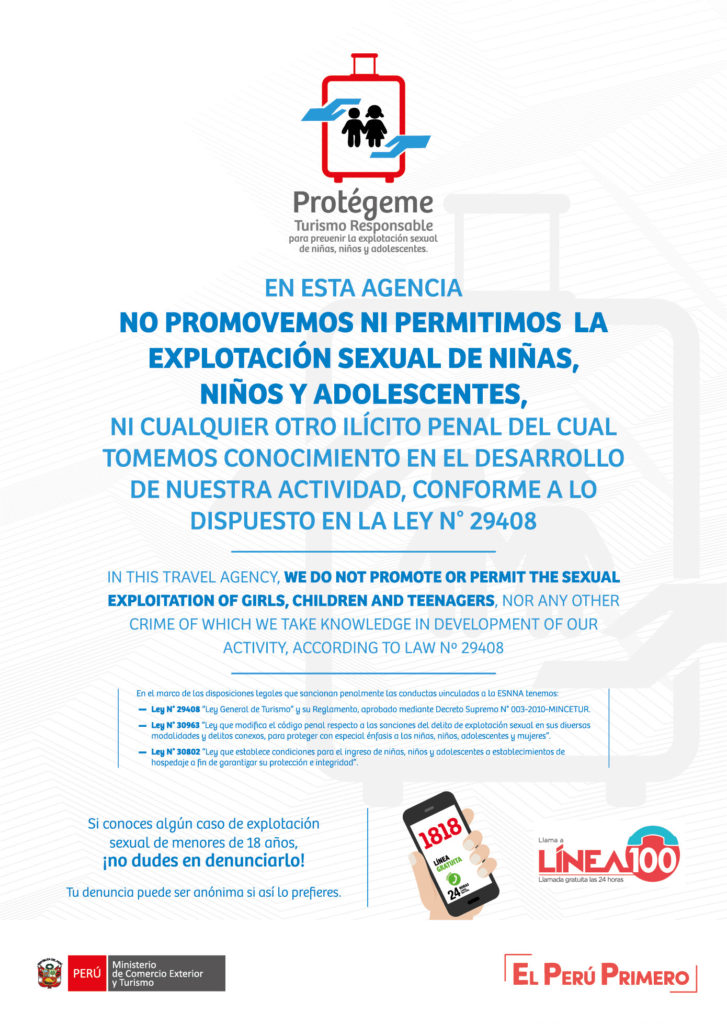FERTUR PERÚ TRAVEL SAC POLICY FOR THE PREVENTION OF THE SEXUAL EXPLOITATION OF CHILDREN (ESNNA)
If you visit our offices, you’ll notice the following sign prominently displayed. This page explains why these signs are there and what they mean.

PURPOSE
Our Child Sexual Exploitation Prevention Policy aims to establish the guidelines that Fertur Perú Travel SAC (our organization), partners, contractors, and third parties must adopt in the performance of their activities to guarantee the protection of the rights of children and adolescents and to prevent any form of sexual exploitation, including pornography and sex tourism.
Our policy complements and wholeheartedly supports (ESNNA), which is the Code of Conduct promoted by MINCETUR (Ministry of Commerce and Tourism) in conjunction with the tourism sector and the prevention of SEXUAL EXPLOITATION OF GIRLS, BOYS AND ADOLESCENTS.
This policy is a commitment by Fertur Peru Travel SAC to help prevent child sexual exploitation, child trafficking, child prostitution, and child pornography, and to comply with the rules and regulations issued by local authorities.
The Code of Conduct for Tourism aims to commit tourism companies to social responsibility and an ethical corporate policy against the sexual exploitation of children in the tourist destinations where they operate. The Code requires companies to train their staff and disseminate information to tourists.
SCOPE
Compliance with this policy is required of all our employees, whether they act as directors, employees, or related third-party contractors.
DEFINITIONS AND ABBREVIATIONS
Children and Adolescents under the age of majority, for the purposes of this policy, the definition provided in the Convention on the Rights of the Child is adopted, which defines it as every human being under the age of eighteen, unless, by virtue of local laws, the majority is reached before eighteen. (ESNNA) Sexual exploitation of children in the field of tourism – is the commercial sexual exploitation of a child or adolescent by a person or persons traveling within their own country or abroad, and engaging in sexual activity with children or adolescents, with the complicity by omission or action of tourism service providers.
Child pornography: Includes any depiction of a child or adolescent engaging in or encouraging sexual activity, any depiction of a minor for predominantly sexual purposes, and any live entertainment organization that features any sexual depiction of children or adolescents. Pornography can be transmitted through any medium.
UNICEF, or the United Nations Children’s Fund, is a United Nations (UN) program that provides humanitarian aid and development programs for children and mothers in developing countries. The Convention on the Rights of the Child (CRC) is an international treaty adopted by the United Nations in 1989 that establishes the civil, political, economic, social, health, and cultural rights of children. It defines a child as any human being below the age of eighteen and requires states to act in the child’s best interests.
Optional Protocol. This is the additional protocol to the Convention on the Rights of the Child on the sale of children, child prostitution, and child pornography. United Nations Resolution A/RES/54/263, issued on May 25, 2000, entered into force on January 18, 2002.
CONTENT
In compliance with the policy for the protection of the rights of children and adolescents regarding all forms of sexual exploitation, our organization and its collaborators are obligated to:
- When providing accommodation, food, and recreation services, refrain from any tourist practice, information, or guidance that in any way promotes, insinuates, or may lead to any form of sexual exploitation, pornography, and sex tourism involving children and adolescents, including the use of photography, recording, or video.
- Report to the competent authorities any suspicious event or situation that they become aware of, which has led to or may lead to the sexual exploitation of children and adolescents, including the existence of websites related to the sexual exploitation of children and adolescents.
- Encourage your suppliers to adopt a similar policy, which should be internally adopted and incorporated into the contracts entered into by each company.
Policy to support the Ministry of Foreign Trade and Tourism (MINCETUR) for the prevention of sexual exploitation of girls, boys and adolescents (ESNNA)
PURPOSE
Our Child and Adolescent Sexual Exploitation Prevention Policy aims to establish the guidelines that Fertur Peru Travel SAC (our organization), partners, contractors, and third parties must adopt in the performance of their activities to ensure the protection of the rights of children and adolescents and to prevent any form of sexual exploitation, including pornography and sex tourism.
Our policy complements and wholeheartedly supports (ESNNA), which is the Code of Conduct promoted by MINCETUR (Ministry of Foreign Trade and Tourism) in conjunction with the tourism sector and the prevention of SEXUAL EXPLOITATION OF GIRLS, BOYS AND ADOLESCENTS.
This policy is a commitment by Fertur Peru Travel SAC to prevent child sexual exploitation, the sale of children, child prostitution, and child pornography, and to comply with the rules and regulations issued by local authorities.
The Code of Conduct in the field of tourism aims to commit tourism companies to assume social responsibility and an ethical corporate policy against the sexual exploitation of children and adolescents in the tourist destinations where they operate. The Code requires companies to train their staff and disseminate information to tourists.
REACH
Compliance with the policy is required by all of our employees, whether they act as directors, employees, or related third-party contractors.
DEFINITIONS AND ABBREVIATIONS
Children and adolescents under the age of majority, for the purposes of this policy, the definition provided in the Convention on the Rights of the Child is adopted, which defines them as every human being under eighteen years of age, unless, by virtue of local law, the age of majority is reached before eighteen. (ESNNA) Sexual Exploitation of Children in the field of tourism – is the commercial sexual exploitation of a child or adolescent by a person or persons who travel within their own country or abroad, and carry out sexual activities with children or adolescents, with the complicity through omission or action of tourism service providers.
Child pornography: Includes any depiction of a child or adolescent engaging in or inciting sexual activity, any depiction of a minor for predominantly sexual purposes, and any organization of live performances of sexual performances by children and adolescents. Pornography can be transmitted through any medium.
UNICEF, or the United Nations Children’s Fund, is a United Nations (UN) program that provides humanitarian and development assistance to children and mothers in developing countries. The Convention on the Rights of the Child (CRC) is an international treaty adopted by the United Nations in 1989 that establishes the civil, political, economic, social, health, and cultural rights of children. It defines a child as every human being under the age of eighteen and requires states to act in the child’s best interests.
Optional Protocol. This is the additional protocol to the Convention on the Rights of the Child on the sale of children, child prostitution, and child pornography. United Nations Resolution A/RES/54/263, issued on May 25, 2000, entered into force on January 18, 2002.
CONTENT
In compliance with the policy on the protection of the rights of children and adolescents against all forms of sexual exploitation, our organization and its collaborators are obligated to:
- When providing accommodation, food, and recreation services, refrain from any tourist practice, information, or guidance that in any way promotes, insinuates, or may lead to any form of sexual exploitation, pornography, and sex tourism involving children and adolescents, including the use of photography, recording, or video.
- Report to the competent authorities any suspicious facts or situations that they become aware of, which have led to or may lead to the sexual exploitation of children and adolescents, including the existence of websites related to the sexual exploitation of children and adolescents.
- Encourage your suppliers to adopt a similar policy so that it can be internally adopted and incorporated into the contracts signed by each company.
